I was sent those photos by reader Marcus K (thanks, Marcus!) showing a pistol in the Polish Home Army Museum in Krakow. The gun is a Bergmann M1910/21 semiauto pistol which has been modified in a couple ways – allegedly by fighters during the Warsaw Uprising.
The main modifications are pretty obvious – the barrel has been lengthened and the magazine replaced with a much larger one. The original barrel would have been just 4 inches (101mm) long, and the new barrel looks to be closer to 12 inches (300mm) plus its muzzle brake.
The original magazine would have had a 6-round capacity, and fit flush with the bottom of the magazine well. This new magazine is a modified Soviet PPS-43 magazine. The rib on the back of the magazine has been cut off at the magazine well, along with the protruding tab on the follower, and presumably a new magazine catch hole has been cut to fit the Bergmann’s magazine catch.
Just looking at the gun, we can tell it’s not in such good shape internally – both the bolt and the slide are sitting out of battery. That means the springs are gummed up with grease at best, and broken or missing at worst.
There are also a bunch of questions that the gun raises:
Was the caliber changed to 7.62x25mm Tokarev or was it left in 9mm Largo? The PPS-43 magazine would fit either cartridge, and if the magazine was available it might mean that the gunsmith had a source of Tokarev ammunition as well.
Was the gun re-sprung on account of the new barrel? That barrel adds a lot of mass to the recoiling parts of the design, and it might need a lighter spring to run reliably. Of course, if it was rechambered for 7.62 Tokarev, that might provide the extra energy to cycle properly.
Was the gun left semi-automatic or was it also modified to fire full-auto? There is a what looks like a button added just behind the trigger which is not normal for the 1910/21. I suspect that is a semi/full selector switch added by whoever did the work on this pistol. 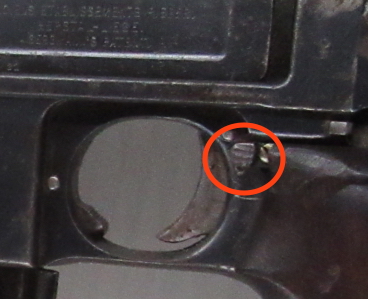
Now, I personally would prefer to have either a semiauto pistol with a short barrel or a full-auto capability coupled with a longer barrel and a shoulder stock to make the weapon controllable, but in circumstances like the Warsaw Uprising people would have different preferences and opinions. Some people always will gravitate towards machine pistols for the perceived firepower (even if it can’t be exploited effectively), and sometimes concealment will take priority over utility.

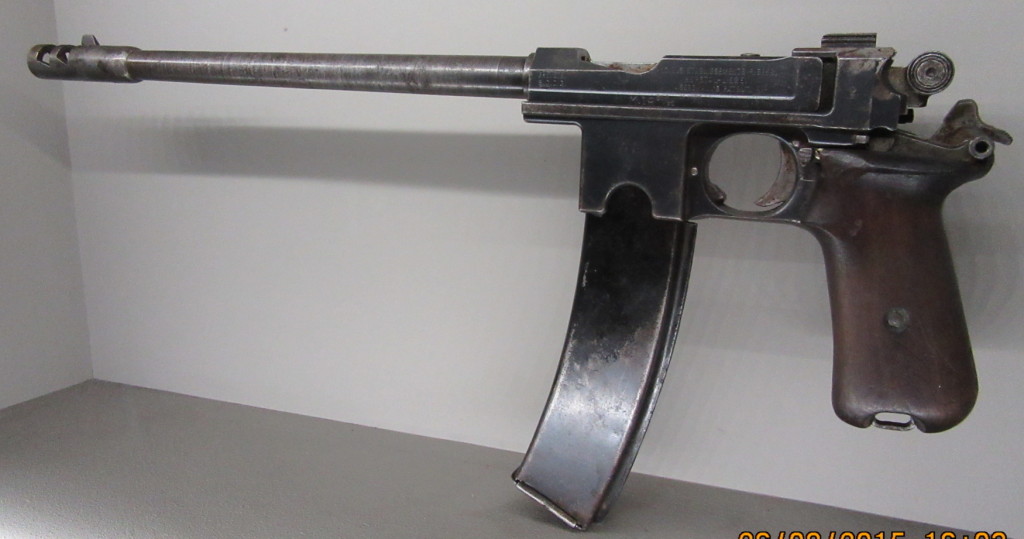
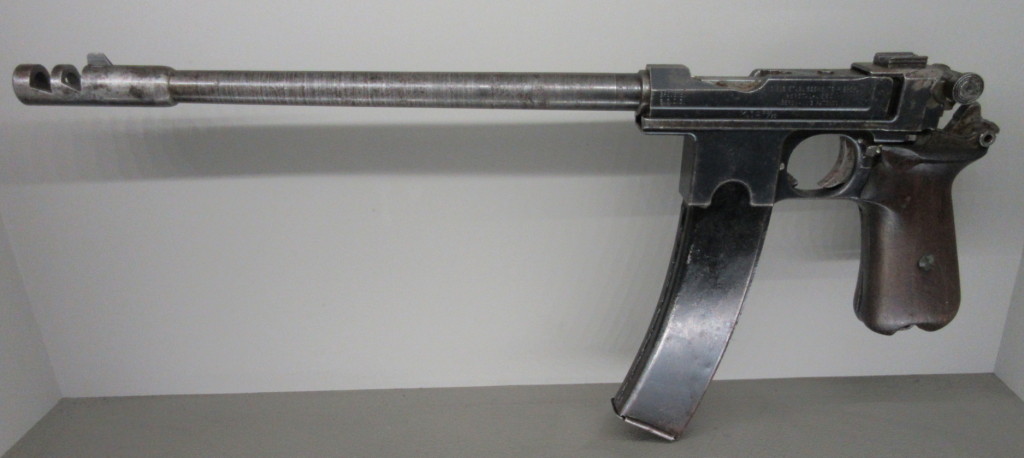
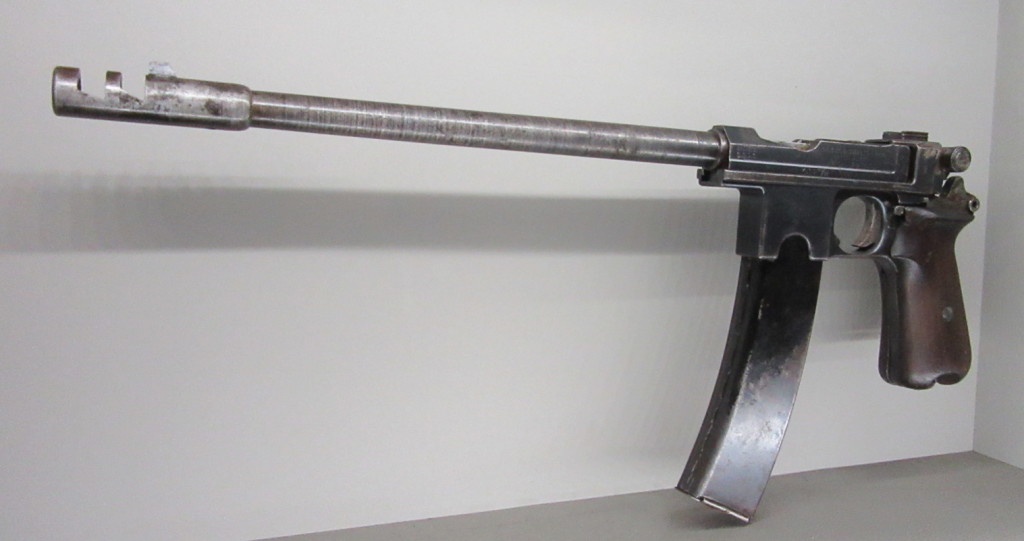
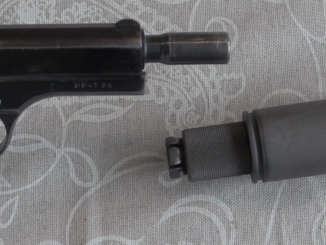

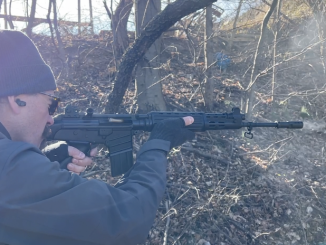
As the Bergmann had a recoiling barrel I’d be amazed if you get decent function out of it with that hunk of a barrel mounted to it. And what that would do to the frame in full auto doesn’t bare close scrutiny either. Makes you wonder if it’s in decent shape because whoever built it tried it and decided “No”.
Mu the Bergman like the C96 Broomhandle had recoiling barrel…. there are plenty of long barreled C96 carbines to disprove your theory that function would be impaired….
As to the author’s remark about needing lighter springs….. with increase velocity from the longer barrel a heavier springs would be needed…. this should also aid in keeping the weapon from beating itself to death…..
There are plenty of guns, including rifles, with recoiling barrel mechanisms, but the longer barrels were taken into account when the gun was designed. This is the equivalent of hanging an extra pound weight on the original barrel and hope it still works.
The other issue of course is how to actually hold on to this gun while firing, the only way I can see is grabbing the magazine. What is most cases is also not recommended for good function, especially with an adapted magazine like this one.
IIRC, most such, like the OM Parabellum “carbine” in 7.65 x 22mm, had either a second “helper” recoil spring concealed in the wooden forearm, used a special “carbine” load with greater muzzle velocity with the standard-weight bullet to increase recoil impulse, or sometimes both.
One like this, with springs balanced for the 9 x 23mm Bergmann-Bayard (which is a fairly hot load to begin with), using (probably) Russian-issue 7.62 x 25mm (which was loaded significantly hotter than the German 7.63 x 25mm original), might not have too much trouble hauling everything back into battery.
Of course, its present state might indicate that full-auto fire with loads like that battered the h**l out of its locking system, searage, and frame, too.
cheers
eon
Interesting that the designer/modifier chose to go through the trouble to add a muzzle brake to a recoil-operated pistol. The brake would certainly reduce the impulse to cycle the weapon, in addition to the barrel mass and barrel length.
MOST BEAUTIFULL (AND BADASS) BERGMANN PISTOL EVER .
I REMEMBER , THE SPANISH BERGMANN IN 9MM LONG HAD FATIGUE MATERIALS PROBLEMS WHERE THE SLIDE BUMPED WITH THE FRAME!
SURELY NOT BEING SAFE TO FIRE
A NAZI OFFICER ASSASSINATION WEAPON?
I would expect, given the firearm’s origin, that it was assembled to make a non- functional firearm into a functional one. A lot of time and energy expended if this is not the case. From the photo, it looks like the muzzle brake is part of an add- on barrel. Any thoughts?
Muzzle brake looks unique to me. Do you know any weapon which might be pattern for this muzzle brake?
I wonder: is muzzle brake and barrel one piece of metal or they are welded together? If second: is barrel made from scratch or salvaged from other weapon? If so which weapon could deliver that barrel?
The muzzle brake looks like it was (crudely) copied from the one on the Beretta M38/42;
http://www.warrelics.eu/forum/attachments/world-firearms/129330d1281801030-beretta-m38-42-a-mab_4_1.gif
It looks like simply a piece of pipe cut and ground to shape and then sweated or brazed to the barrel proper.
It would effectively reduce climb, just as the even cruder folded sheet-metal “brake” of the PPSh did;
http://world.guns.ru/userfiles/images/smg/smg02/ppsh41-1.jpg
As for the barrel, if it is 7.62 x 25mm, which I suspect it is, any .30 caliber or 7.62/7.65mm rifle could have supplied it. All that would be required would be a chambering reamer for 7.62 x 25mm, which given the necessary materials (tool steel blank, carbide cutting bit) and the specs (cartridge + micrometers) could have been run up on a small lathe. Such as you’d find in a jeweler’s or watchmaker’s shop, for instance.
cheers
eon
my bergmann has one 10 rd mag, and I love the pistol. I also appreciate this modified bergmann and would like to own it too.
Forget getting 9 Largo in occupied Poland – it was probably modified to 7,62×25, hence the PPS magazine and – probably – the bbl. The compensator is true fantasy, very 1950-ish, and I strongly suspect the whole shebang to be a post-war illegal artisan work.
“A crude compensator is built into the barrel jacket, intended to reduce muzzle climb during automatic fire. The compensator was moderately successful in this respect, but it greatly increased the muzzle flash and report of the weapon.” Thats a Wikipedia extract about a Ppsh, just saying.
It’s no stock, in 7.62x25mm full auto it might have some muzzle rise… So they thought to compensate that, in order to make it feasible perhaps.
It might well be post war, but trying to make a smg in the war is understandable… If there’s multiple huns, they have smgs and seen to think they are appropriate.
To all who comment on the muzzle brake, it’s not as such
The ports do not point backwards, but up.
Soi it is a compensator to counter muzzle climb.
The longer barrel increases both muzzle velocity, and hence recoil ( for every action there is an equal but opposite reaction).
And inertia. (Acceleration= force/ mass)
Without doing the maths, I’m not sure where the balance would lie.
.30 tok and mauser loadings are roughly equivalent in recoil impulse to 9mm p. (As hot or hotter than 9mm largo pistol loadings).
IIrc, from Ian’s series on Bergman pistols, the disconnector is on the trigger mechanism, rather than detecting the slide returning to battery. That would make a full auto conversion “interesting” in all of the wrong ways.
The ppsh mag mods would be an interesting winter evenings project for someone with a shooter quality Bergman Bayard.
Keith, I’m not sure that I agree that increasing the barrel length increases the recoil momentum or recoil energy. A significant amount of the recoil impulse comes from the propellant gases exiting the muzzle. I think increasing the barrel length (to say nothing of increasing its mass) would likely reduce the recoil, especially for a pistol round having a small propellant mass. The muzzle brake/comp makes no sense to me for the same reason – it is diverting propellant gases in a completely unhelpful direction.
It looks cool though!
Considering the circumstances under which this weapon was produced/modified, one wonders if all of the technical minutiae were clearly thought out, or was this simply one tinkerer’s (think a Polish Bubba) way of getting his hands on a “machine gun” at a time when the odds of survival were virtually nonexistent anyway. Like the Liberator, it only had to work well enough to get ahold of a better weapon like an MP 40 or 44. Another question is how easily would Soviet ammunition and magazines been obtained in a city under German occupation? Were they from captured stocks previously issued to rear-echelon German units or were the Soviets covertly supplying the Polish resistance just enough to cripple the Germans but not be a threat to the coming Soviet occupation? Could the holster/stock have originally been on the pistol but subsequently lost or discarded? (That would have made it a somewhat more useful weapon.) It is hard to imagine the chaos of such a situation as the Warsaw uprising when desperation ruled among the insurgents, and the only choice was whether to die on one’s feet or on one’s knees. Would it be my first choice as a combat weapon? No, but if I thought it would help me to take out a few of those bastards before they killed me, I’d be happy with it.
Getting one’s hands on a better weapon would have been a priority, seeing as this was converted from a weapon whose ammunition was not in good supply. Just one spray and Hans’ stuff (minus his rifle) goes to his next of kin…
They probably needed combat- Battlefield weapons, they’ve tried to turn this pistol into a smg seemingly..
An uprising has gone past the cloak and dagger stage, ze Nazis would presumably shoot at anything not wearing a German uniform at that point women holding babies and whatnot with pistols in their bags are probably of limited use if they are targets.
That much is obvious and will make the Poles even more determined to kill anything wearing feldgrau. The Poles may have lost the battle but the Germans are in no condition to fight the incoming Russians after having lost so much material just to “subdue” one city full of incredibly pissed-off Poles…
They did lose though… And it was probably in 7.62x25mm
From what I have read, the numbers of Poles involved in the resistance were only a small percentage of the population of Warsaw, but give a person with nothing to lose a weapon of any type, even if it is a gas pipe zip gun, and they can be quite dangerous and effective. The innovation the Poles displayed with a variety of homemade SMGs and even the Kubus armored car is pretty amazing and the courage with which they were employed is truly inspirational. Sometimes, when I am having a bad day, I will see something like that Bergmann or look at one of the old relics that I have lying around and remind myself that things could be a whole lot worse.
“homemade SMGs”
Most Polish SMG were less-or-more changed STEN sub-machine gun:
Błyskawica SMG has magazine sticking downward, pistol grip and hinged stock
KIS SMG has magazine sticking to side, pistol grip, no stock
However there were also other SMG not related to STEN:
Choroszmanów SMG was based on PPD-40 and fire 7.62×25 Tokarev round
Bechowiec-1 SMG was original design
Other weapons during occupation were:
Filipinka hand grenade (marked ДУГ to suggest that it was manufactured in Soviet Union)
Sidolówka hand grenade
K pattern flamethrower
Pdb I think you’re right on the money. I remember reading that survivors of the uprising reflected that the pistol they had were the least useful of their weapons. Like you say there was a point where anyone became a target. I wish I could recall where I read that.
“Like the Liberator, it only had to work well enough to get ahold of a better weapon like an MP 40 or 44.”
If so why make muzzle brake? It is essential to weapon working?
“Soviet ammunition”
Germans used 7.63×25 Mauser ammunition in captured PPSh sub-machine gun (which they called MP.717(r)).
If left 9mm largo could it shoot 9mm parabellum?
There is an oral history, I think that was it was, that suggests that there were Spanish fighters that the Poles referred to as “Our Spaniards).
As of the 1944 Warsaw uprising where weapons were manufactured in Warsaw, I noticed that Thompson submachine guns had been apparently dropped in as well as the Poles making an indigenous mg. This might have been a second class weapon to allow for better weapons for the main fighting. Something more for show than fighting but still capable of limited shooting?
My understanding is that a 9mm largo can fire 9mm parabellum if an extractor is there to hold it in place. Not recommended but worthwhile in that context.
Keep in mind that the Bergmann 1910/21 was a standard Danish Army pistol in addition to being used in Spain.
Also, Bergmann developed a selective-fire version of the 1910/21 with an extended magazine “in-house” before the war, apparently intended to compete with the Mauser M712 “Schnellfeuer”.
The Schnellfeuer was issued to Wehrmacht motorcycle dispatch riders on the Ostfront. It was also popular with the SS, especially the Einsatzkommando groups.
So, it’s not too far-fetched to postulate that this hotrodded Bergmann was originally from Denmark, and was redone (probably from unusably poor condition) as a “Schnellfeuer”-style arm because the original Mauser version was already in use in the area.
cheers
eon
Do you think that the barrel could be a smoothbore (maybe like the Avenger) with the weapon modified to be a direct blowback operation?
These guns were not built to last, just to maybe kill and/or maim a few Nazis.
Man, I would love to coon finger this weapon and delve into it’s secrets. Surely there is someone at the Museum that could help us out. Now I won’t be able to sleep tonight.
The barrel is almost certainly from a scrapped .30 cal class rifle. One reason the Soviets were so pumped on 7.62mm pistols and SMGs was that they could make the barrels on the same machinery they used to turn out 7.62 x 54R Mosin-Nagants.
During the Israeli War of Indepenedence, the Haganah’s underground arms factories turned out Sten copies by using scrapped British 0.303in SMLE barrels. They would cut them to length (1 rifle barrel = 2 Sten barrels) and then bore them out to 9mm and rifle and chamber them.
I don’t think that’s the case here. I think that the barrel is still 7.62mm or thereabouts. The Polish Home Army and the Warsaw guerrillas would use things “as is” as much as possible. There would be little point in boring out a still-decent 7.62 barrel to 9 if 7.62 ammunition could be had.
As for the muzzle brake, they probably noticed how Schnellfeuers climbed on full- auto and took measures to keep it more-or-less on target. (I.e., not a danger to low-flying birds.)
cheers
eon
In firing, if standart lenght of barrel throws unburned powder charges out of the barrel and, if all the powder charge is usable in a longer barrel, it surely increases the muzzle velocity and the recoil force. Besides, the bullet remaining longer time in the barrel needs a longer unlocking distance of barrel and breechbolt, therefore, both needing a
more powerfull action spring to cushion the recoil kick and also, to return the recoiled barrel to the foremost position in the receiver. Basic recoil formula does not include muzzle blast effect since it varies with muzzle shape and area. The battery off position of this particular pistol may be by the cause of using standart recoil spring which remains weak, for a rather longer time of firing. IMHO.
Though recoil depends upon velocity multiplied by mass, the recoil force applied on a recoil operated locked breech firearm will vary by the added mass of barrel lenght and by the gained initial velocity. This assignes the acquired final recoil force and it may be lower or higher than the shorter barrel. But, in case of same recoil distance is used for the movable barrel for greater lenghts as being in this particular pistol, the remaining gas inside the barrel will be more volumed and more push power against to the breechblock which will remain as lacked with the mass of barrel to overcome the recoil force and eventually will get more recoil speed than the shorter barrel. Therefore, needing a powerfull return spring to cushion the recoil stroke.
“Go, passer-by, and tell the world that we perished in the cause, faithful to our orders.”
The Warsaw Uprising was a stellar point in human history that demonstrated the ideal that death in pursuit of freedom from oppression is more important than living in subjugation. The context that should be considered is that the Freedom Fighters did not expect to live but were willing to die in the struggle. It was the classic demonstration of Urban Warfare. The supporters of the resistance scoured every source of any type of weapon and one of the main and most effective was the so-called Molotov Cocktail that was made with fuel siphoned from the fuel tanks of disabled Nazi vehicles after the crews had been killed in close in fighting. The Resistance learned that blending detergents, especially home-made soap, with the fuel made a crude but very effective Napalm that would “stick” to vehicles and uniforms. Many time the Freedom Fighters attacked Panzer tanks and armored vehicles with a bottle of this crude fuel and a short section of cloth. If they could get on top of a tank and smash this on the grill above the engines they destroyed a very expensive piece of equipment and a well-trained crew for just pennies in resources. Every vehicle they destroyed was one that would not be available to meet the liberating Allies. Weapons such as the Bergmann did not have to last for years in hard combat; the uprising only lasted for 66 days. If the weapon had a life-cycle of 50,000 rounds that was inconsequential … that was more ammunition than was available to the whole of the Resistance at any one point in time. These modified weapons only had to last for one battle/skirmish. If this garnered several Nazi weapons and ammunition the fighter considered the price to be well worth the cost of his weapon and his life. If the weapon was fully automatic or selective fire, so much the better. In close-in fighting such as attacking a vehicle or small patrol from less than half the width of a street, it was good enough for the task. This was also a classic motivation by the classic dictum, “The reason there are Slaves is because there are Kings; the reason there are Kings is because people allow themselves to be made Slaves!” According to some of my Polish friends, the second dictum of these fighters was that of Chief Tecumseh of the Shawnee who reportedly said, “If I must die in this struggle, then let me do so with Honor.” (As Dustin Hoffman said in Little Big Man, “Us Indians talk sort of funny sometimes.”) To me this weapon as represented is akin to the Filipino slam fire shotguns called “paliuntods” or “paltiks,” the Montagnard crossbow and other examples of hasty weaponry … they did the job at hand when required and should be preserved as an memorial to the indomitable inventiveness of these fighters as well as the spirit of those who would live free.
Indeed. The firearm shown here may have worked well, it may have not. Ask yourself what you learn in the dire case you are faced with similar choices.
1. The darkness is your friend.
2. Silence is golden.
3. Never face someone if you can get behind them.
4. Never give a sucker- or an enemy- an even break.
5. Do unto others, then leave quickly, quietly, and inconspicuously.
It’s interesting having an ex-CIA field executive for a college professor.
cheers
eon
Reminds me of my ranger training before that “crazy Asian war”! And it worked!
Or two uncles … Google “Mena, Arkansas Intermountain Airport”
I like seeing one off arms like this. It is probably going to be impossible to tell for sure if the firearm in this configuration dates to the WWII era. If so then my impression is that someone had it ready to go long before the hostilities got rolling. The only thing as others have commented on it the arm is recoil operated & has a muzzle brake resembling those on the Italian WWII period Beretta smgs.
I have not read up on the AK fighters but a firearm like this (concealable, in 7.62X25mm, with what a 10 round capacity, possibly with full auto on tap, would be just the thing to have when doing security for a person moving supplies around. Just whip it out when at RONA man gets in your face, pull trigger repeat. This probably wwould be more useful at night.
If it is from the Post WWII period, then maybe it came from some of the Jewish post WWII arms caches. It has been reported that anti Jewish activities carried on in Lodz, as very sad footnote in history.
Tony baloney wrote “If it is from the Post WWII period, then maybe it came from some of the Jewish post WWII arms caches. It has been reported that anti Jewish activities carried on in Lodz, as very sad footnote in history.”
That’s interesting theory, could you point to any relation of such an incidents (especially involving firearms) in post-war Lodz? What kind of Jewish underground organisations carried weapons? I never heard or read anything about such an incidents in Lodz, actually it was one of a places in Poland in which Jewish community and culture had it’s best times after the war, 46 thousands of Jews come back to Lodz. Central Committee of Polish Jews had his headquarters in Lodz, there was two Jewish schools, theatres, over 20 Jewish newspapers were edited and printed in Lodz. The fact is that Soviet imposed communist government tried to stop this reconstruction of Jewish community, half of a Jews emigrated in 1946 and some more in 1956 – 1957 after political thaw but as far as I know there wasn’t any serious anti Jewish activities and more importantly none of a Jewish arms caches.
Hugo and Hans Smeisser was in Otterup at Schults & Larsen in 1921-22 wherethey developed several automatic firearms: MP 1932 and 1935 and a modifaktion of the the MG 17. and an assault rifle, was also made in 7X 36 Madsen.
Otterup was called Industri werke Bergmann Werk Otterup